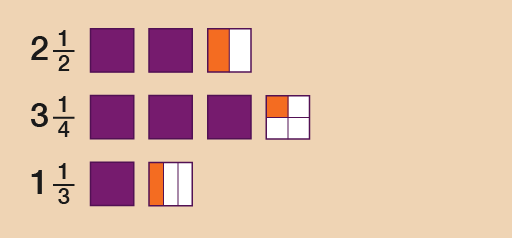3.2 Drawing fractions
Example: Drawing the fractions
If you need to compare one fraction with another, it can be useful to draw the fractional parts.
Look at the mixed numbers below. (A mixed number combines a whole number and a fraction.) Say you wanted to put these amounts in order of size, with the smallest first:
2 , 3 , 1
Method
To answer this you could look at the whole numbers first and then the fractional parts. If you were to draw these, they could look like this:
So the correct order would be:
1 , 2 , 3
Use the example above to help you with the following activity. Remember to check your answers once you have completed the questions.
Activity 20: Putting fractions in order
- Put these fractions in order of size, smallest first:
- 5 , 6 , 2
- Put these fractions in order of size, smallest first:
- 2 , 1 , 2
Answer
- The correct order would be:
- 2 , 5 , 6
- In this case, even though is bigger than and is bigger than , you need to look at the whole numbers first and then the fractions. The diagram illustrates this more clearly:
- The correct order would be:
- 1 , 2 , 2
- Looking at the whole numbers, 1 would be the smallest because the other two mixed numbers are both greater than 2. To see which is bigger out of 2 or 2 , you need to compare the fraction part. Which is bigger: or ?
- To work this out, you could draw images as above, or you could use the method we looked at earlier where you change to equivalent fractions – the bottom numbers of the fractions are 5 and 2, and the lowest common multiple of 5 and 2 is 10:
- 5 × 2 = 10
- 2 × 5 = 10
- Whatever you do to the bottom, do to the top:
- If you mulitiply the top and bottom numbers in by 2, you make .
- If you mulitiply the top and bottom numbers in by 5, you make .
- () is smaller than (), so 2 is smaller than 2.


